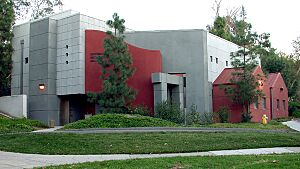Entomology Research Museum facts for kids
The Entomology Research Museum is a huge collection of insects at the University of California, Riverside. It's like a giant library, but instead of books, it holds millions of tiny creatures! This museum helps scientists study insects from all over the world.
The museum has about 4 million insect specimens. Most of these, over 3 million, are carefully pinned. About 400,000 are on slides, and others are kept in special liquid called ethanol. This liquid also preserves other small creatures like arthropods (which are like insects but include spiders and crabs) and even some snails.
Scientists have identified about 75% of these 4 million specimens. This means they know the genus (a group of similar species) or even the exact species for most of them. The collection has many different types of insects. About 25% are Hymenoptera (like bees and wasps), 21% are Coleoptera (beetles), 18% are Diptera (flies), and 18% are Lepidoptera (butterflies and moths).
Contents
History of the Museum
The Entomology Research Museum is the second oldest insect collection in the University of California system. Its story began in 1923. That's when the first insect specimens were moved from the California State Insectary in Sacramento. This important move was done by a scientist named Harry Smith.
How the Collection Grew
Over the years, many other large insect collections were added. For example, P.H. Timberlake added his collection in 1924. Later, in 1948, L.D. Anderson also contributed his specimens. In 1965, the museum bought the G.P. McKenzie collection. This collection focused on beetles from North America.
The museum was officially organized by E.I. Schlinger in 1962. Today, it is one of the 20 largest insect collections in the United States. It's also one of the top 10 largest collections found only at a university. For some special groups of insects, especially those from southern California, the museum's collection is even more important globally.
Special Insect Collections
The museum has some truly unique and important collections. One of the most famous is its collection of Chalcidoidea. These are tiny parasitic wasps, and the museum has one of the biggest collections of them in the world.
Tiny Wasps on Slides
The collection of Chalcidoidea on slides is especially amazing. There's nothing else like it anywhere! It has over 100,000 slides of these tiny wasps. Many of these are from families like Trichogrammatidae, Aphelinidae, Mymaridae, Eulophidae, and Encyrtidae.
Other Important Insects
The museum also has special collections of other insects. These include:
- Apoidea (bees)
- Asiloidea (a group of flies, especially Bombyliidae (bee flies), Therevidae (stiletto flies), and Asilidae (robber flies))
- Meloidae (blister beetles)
- Thysanoptera (thrips)
- Staphylinidae (rove beetles)
- Melyridae (soft-winged flower beetles)
- Coccinellidae (ladybugs)
- Sciomyzidae (marsh flies)
- Tephritidae (fruit flies)
- Miridae (plant bugs)
- Aphididae (aphids)
- Coccoidea (scale insects)
- Specific types of scarab beetles, like Pleocoma and Chrysina.
The museum also holds over 1,100 primary types. A "holotype" is the single specimen used to describe a new species. There are also thousands of "paratypes," which are other specimens of the same new species. Many of these important specimens were collected by P.H. Timberlake.
Where Do the Insects Come From?
Most of the insects in the museum come from southern California, Arizona, and the Baja California Peninsula. This includes one of the largest collections of insects from the Sonoran Desert. This desert covers parts of California, Arizona, and Mexico. The museum also has many insects from the Coastal sage scrub areas.
Global Reach
While many insects are from the local area, the museum also has specimens from far away. There are significant numbers from:
- Northern California
- Other parts of the U.S.
- Mexico
- Central America
- South America
- The Russian Far East and its European part
- India
- Australia
- South Africa
- Thailand
The collection of parasitic wasps is the most diverse, meaning it has specimens from all over the world. Some of these wasp specimens date back to the early 1900s!


